Racing Club de Avellaneda
Racing Club de Avellaneda, also known simply as Racing, is an Argentine professional sports club based in Avellaneda, a city of Buenos Aires Province. Founded in 1903, Racing has been historically considered one of the "big five" clubs of Argentine football. Racing currently plays in the Primera División, the top division of the Argentine league system.
.svg.png.webp) | ||||
| Full name | Racing Club | |||
|---|---|---|---|---|
| Nickname(s) | La Academia (The Academy) | |||
| Founded | 25 March 1903 | |||
| Ground | Estadio Presidente Perón, Avellaneda | |||
| Capacity | 61,000 | |||
| President | Víctor Blanco | |||
| Manager | Juan Antonio Pizzi | |||
| League | Primera División | |||
| 2019–20 | 3rd (aggregate table) | |||
| Website | Club website | |||
|
| ||||
| Active departments of Racing Club | ||||||||||||||||||||||||||||||
|---|---|---|---|---|---|---|---|---|---|---|---|---|---|---|---|---|---|---|---|---|---|---|---|---|---|---|---|---|---|---|
|
Racing has won the Primera División 18 times (with a record of seven consecutive championships between 1913 and 1919, five of which were won undefeated), apart from winning 13 National cups such as five Copa Ibarguren, four Copa de Honor Municipalidad de Buenos Aires and one Copa Beccar Varela.[1] Due to those achievements the team was nicknamed La Academia ("The Academy of Football") which still identifies the club and its supporters.[2]
On the international stage, the club has won 7 titles, with 3 of them organised by CONMEBOL[3] and other international bodies. Those achievements include one Copa Libertadores, one Intercontinental Cup and the first edition of the Supercopa Sudamericana. In addition, Racing won AFA-AUF competitions, played against the Uruguayan champions: Copa Aldao twice and Copa de Honor Cousenier once, and the Supercopa Interamericana.[4][5]
The first team plays its home games in the Estadio Presidente Perón, nicknamed El Cilindro de Avellaneda (in English: "The Cylinder of Avellaneda"). The team is identified by the colors light blue and white, in honor of Argentina. Apart from football, other sports practised at Racing are artistic gymnastics, basketball, boxing, field hockey, handball, martial arts, roller skating, tennis and volleyball.[6]
History
Origins
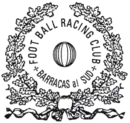
The origins of the club can be traced to the end of the 19th century, when a group of Buenos Aires Great Southern Railway employees asked for permission to play football in a field belonging to the company. As the request was approved, they started to play their first matches there, mostly against teams formed by British immigrants.
In 1898, they founded a club, "Argentinos Excelsior Club", which lasted three years until in 1901, three new clubs were established "Sud América Fútbol Club de Barracas al Sur", "American Club" and "Argentinos Unidos", with Barracas al Sur the most notable of them. Nevertheless, the club was soon disbanded, establishing "Colorados Unidos" on 16 March 1902. On 25 March 1903, both clubs met at Mercado de Haciendo with the purpose of merging again.[7]
The club took its name from a French auto racing magazine owned by Germán Vidaillac (a founding partner of French ancestry). The suggestion was well received and the name "Racing Club" was immediately approved.[8] Racing was the first football team integrally formed by criollo people.
The first jersey worn by the emerging club was white, until 25 July 1904, when it was decided a yellow and black vertical striped jersey would be used. Nevertheless, the recently adopted uniform only lasted a week due to its similarity to Uruguayan club CURCC, being replaced by a design proposed by president Luis Carbone. The jersey had four squares, two light blue and two pink. This light blue and pink design would be worn until 1908, once again replaced by a design with three horizontal bars (two blue and one white). Finally, Racing adopted the light blue and white colors in 1910, in commemoration of the May Revolution's 100th anniversary that same year.[7]
First years in football
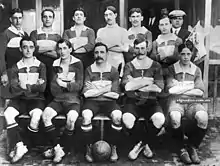
Racing affiliated to the Argentine Football Association in 1905,[7] and began playing in the lower divisions of Argentine football league system.[7] In 1906 the club registered to play in Segunda División.[9]
In 1909, Racing competed in a playoff to promote to Primera División, but lost to Gimnasia y Esgrima de Buenos Aires. Racing finally promoted to the first division in 1910, winning the playoff final against Boca Juniors with an attendance of 4,000. The starting line-up that won the promotion was: Fernández; Seminario, Allan; Winne, Juan Ohaco, Angel Betular; Oyarzábal, A. Ohaco, Firpo, Frers and Juan Perinetti. Frers and Ohaco were the scorers for Racing.[9] The popularity of the club raised after that promotion, increasing its number of supporters.[7]
"The Academy" and the seven consecutive
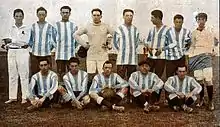
In 1911 Racing debuted in Primera División, finishing in fourth place.[10]
One year later, Racing won its first domestic cup, the Copa de Honor Municipalidad de Buenos Aires after beating Newell's Old Boys 3–0. Racing also played its first international match, v Uruguayan team River Plate.[7]
The first league title came in 1913 when Racing defeated San Isidro and River Plate in a playoff. Racing first eliminated River Plate (3–0), and then played the final against San Isidro, winning 2–0.[11]
In 1914, Racing won its second league title, having scored 42 goals and only 7 received in 12 games. The runner-up was Estudiantes (BA). That same year Racing won its second consecutive Copa Ibarguren, defeating another Rosarino team, Rosario Central, by 1–0 in Buenos Aires. The line-up for the match: Arduino; Reyes, S. Ochoa; Pepe, Olazar, Betular; Canavery, Ohaco, Marcovecchio, Juan Hospital, Juan Perinetti.[12]
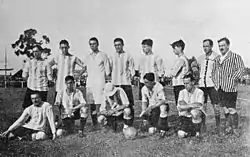
Racing became Primera División champion in 1915 when they defeated San Isidro 1–0 in a playoff at Independiente’s stadium. Their line-up was: Arduino; Presta, Reyes; Betular, Olazar, Pepe; Canavery, Ohaco, Marcovecchio (who scored the only goal), Juan Hospital, Juan Perinetti. Racing finished unbeaten, with 22 games won and 2 drawn, with and 95 goals scored with only 5 conceded.[13]
Racing won the following title, the 1916 championship, totalizing 34 points in 21 games with 39 goals converted and 10 received at the end of the tournament. Platense was the runner-up with 30 points. The 5th consecutive title was in 1917 after totalizing 35 points, being River Plate the runner-up with 30 points. The team also scored the mark of 58 goals with only 4 received in 20 fixtures. In addition, the squad achieved its third Copa Ibarguren with a smashing victory over Rosario Central by 6–0 in Avellaneda. The line-up was: Arduino; Ohaco, Reyes, Viazzi Olazar, Ricardo Pepe; Canavery, Vivaldi, Marcovecchio, Juan Hospital, Juan Perinetti.[12]
That same year Racing won another edition of Copa Ibarguren, defeating by 2nd. consecutive time Rosario Central by 3–2 at GEBA stadium. The line-up was: Crocce; Castagnola, Reyes; Vivaldi, Olazar, Pepe; Natalio Perinetti, Ohaco, Marcovecchio, Minondo, Juan Perinetti.[12]
One year later, Racing won its 6th. league title, remaining unbeaten after 19 games played, with 49 goals scored and 9 received. Racing also won another edition of Copa Ibarguren (5 in total) with a large victory over Newell's Old Boys by 4–0 at GEBA. The line-up: Crocce; Castagnola, Reyes; Ohaco, Marcovecchio, Macchiavello; Natalio Perinetti, Zabaleta, Vivaldo, Juan Hospital, Juan Perinetti.
In 1919 Racing moved to the dissident league "Asociación Amateurs de Football", winning the tournament whilst remaining unbeaten again. Racing played 23 fixtures, winning its 7th. consecutive title with 26 points and 43 goals scored.[14] They won further titles in 1921 and 1925.[15]
The 1930–1940s
Racing was one of the founding members as the first professional league in Argentina, Liga Argentina de Football, that split from the AFA to organise its own championships. During those years Racing won the Copa Beccar Varela in 1932 (defeating Boca Juniors 3–0 in the final) and the Copa de Competencia (LAF) one year later, thrashing San Lorenzo de Almagro 4–0 in the final match. Despite the national cups won, Racing could not win any domestic championship during that period; its best performances were third places in 1932, 1933 and 1936. Evaristo Barrera was the top scorer with 34 goals in 1934 and 32 in 1936.[16]
In 1945 Racing won the first edition of Copa de Competencia Británica defeating Boca Juniors by 4–1 in the final.[17] Despite its domestic cup achievements, Racing didn't win any league title until 1949, starting with another brilliant era of three consecutive championships.
Return to league titles

Racing won the championship three years running between 1949 and 1951.[15] In 1949 Racing finished with 49 points. Besides, two players of the club, Juan José Pizzuti and Llamil Simes, were the topscorers of the tournament with 26 goals each. In 1950, Simes was the topscorer of the time again. That same year, Racing inaugurated its new venue, Estadio Presidente Perón, the second largest stadium of Argentina. Racing won its third consecutive league title in 1951 after beating Banfield 1–0 in a two-leg series. The starting line-up was Héctor Grisetti; Higinio García, José M. Pérez; Juán Gimenez, Alberto Rastelli, Jorge Gutiérrez; Mario Boyé, Manuel Ameal, Rubén Bravo, Llamil Simes, Ezra Sued, with Guillermo Stábile as coach.
Racing could not achieve a four-consecutive title after in 1952 the team finished 2nd to River Plate. The next league title came in 1958, and they were runners-up to San Lorenzo de Almagro the following year.[15]
During those years Racing Club had many notable players that made their contribution to the successful campaigns. Some of them were Norberto Mendez, Rubén Bravo, Llamil Simes, Mario Boyé, Alberto Rastelli, Pedro Dellacha, Ezra Sued, Roberto Blanco, Ernesto Gutiérrez, Pedro Manfredini, Arnaldo Balay, Juan José Pizzuti, Rubén Héctor Sosa and Omar Oreste Corbatta.
International success
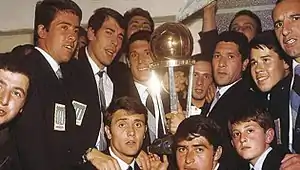
Racing finished 4th in 1960 with a top scoring 72 goals. During this tournament Racing also achieved its largest victory in Primera División, an 11–3 against Rosario Central.[18]
In 1961 Racing won another championship totalizing 47 points when coached by Saúl Ongaro. The team was also the highest scoring team with 68 goals. The next year, Racing finished 9th and was also eliminated from the Copa Libertadores de América in the first stage.
Racing won the Primera in 1966, scoring 70 goals.[19]
In the 1967 Torneo Metropolitano Racing reached the final where the team lost to Estudiantes de La Plata 3–0. That same year Racing won the 1967 Copa Libertadores after beating Uruguayan team Nacional 2–1 in the final. Norberto Raffo was the top scorer with 13 goals.
At the end of the year Racing won the Intercontinental Cup defeating Celtic in a playoff game. The first match had been played at Glasgow where Racing was beaten 1–0 while they won the second game 2–1 in Avellaneda. The playoff was played in Montevideo where Racing achieved its second continental championship winning 1–0 with a goal scored by Juan Carlos Cárdenas. The starting line-up for the playoff match on November 4 was: Agustín Cejas; Oscar Martín, Roberto Perfumo, Alfio Basile, Nelson Chabay; João Cardoso, Juan Carlos Rulli, Juan J. Rodríguez, Humberto Maschio; Norberto Raffo, Juan Carlos Cárdenas. Juan José Pizzuti was the coach.[20]
Relegation
During the 1970s Racing did not win any title, although the team finished 2nd to San Lorenzo in the 1972 Metropolitano, with 43 points in 34 matches. That year was the debut of Ubaldo Fillol, who some regard as the best Argentine goalkeeper ever. Fillol set a record of 6 penalty shots stopped in the same season. From 1974 and 1978 Racing made poor campaigns and was near relegation in 1976 when the team finished next to last (San Telmo was finally relegated).[21]
In 1983, Racing was relegated to the Primera B. The first year in the second division, Racing finished second behind Deportivo Español and so had to play a promotion playoff, where Racing eliminated Deportivo Morón and Lanús but lost to Gimnasia y Esgrima (LP) in the finals (1–3 and 2–4).[22]
One year later, after two seasons in the second division, Racing returned to the top division in 1985 after winning a playoff for the second promotion place against Atlanta; Racing won 4–0 the first game and the second match finished 1–1.[23]
Return to international success
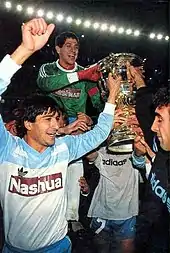
Racing won its third international competition in 1988, when the team won the first edition of the 1988 Supercopa Sudamericana, defeating Brazilian team Cruzeiro in the finals, with Alfio Basile still as coach. That same year Racing won the non-official Supercopa Interamericana beating Sportivo Herediano from Costa Rica 3–0.
Racing also played another Supercopa final and was defeated by Cruzeiro 4–0 in Belo Horizonte. Racing won the 2nd match 1–0 but the cup was awarded to the Brazilian team by goal difference.
Bankruptcy and resurrection
Racing declared bankruptcy in 1999 and for the next nine years were administered by Blanquiceleste PLC.[24]
They won the league title in 2001, 35 years since the previous occasion.[24]
In 2012, Racing reached the final of the 2012 Copa Argentina Final although the squad lost to Boca Juniors by 2–1.[25]
In June 2014, Diego Cocca was hired as head coach.[26] Few days after Cocca signed his contract, former player and fans favorite Diego Milito left Inter Milan and returned to the club to play the 2014 Torneo de Transición.[27]
In December 2014, Racing won its Primera División 17th. title in the last fixture of the tournament. The team defeated Godoy Cruz by 1–0 to secure the 1st place and crowned champion.[28][29][30]
They won the Campeonato in 2018/19.[15] Lisandro López was the top scorer of the tournament with 17 goals, and at the age of 36 he was the oldest player to be league top scorer.[31][32][33]
In December 2019, Racing became champion Trofeo de Campeones de la Superliga Argentina by winning 2-0 to the last champion of the Copa de la Superliga Argentina, Tigre, with two goals from Matías Rojas
Stadium
Racing Club plays its home games at "Estadio Presidente Perón" (named in honor of former President of Argentina Juan Domingo Perón), popularly known as "El Cilindro de Avellaneda" (due to its cylindrical shape) and "the Coliseum". It was opened in 1950 and restructured in 1997.[34]
The field measures 105 x 70 m. Racing's stadium is the second largest in Argentina after the River Plate stadium. In the beginning, the venue could host a capacity of 120,000 but subsequent restructurings reduced its capacity to 64,161.[35]

Players
Current squad
- As of 4 February 2021.[36]
Note: Flags indicate national team as defined under FIFA eligibility rules. Players may hold more than one non-FIFA nationality.
|
|
Out on loan
Note: Flags indicate national team as defined under FIFA eligibility rules. Players may hold more than one non-FIFA nationality.
|
|
Most appearances

| Rank. | Player | Position | Tenure | Match. |
|---|---|---|---|---|
| 1 | FW | 1917–33 | 405 | |
| 2 | DF | 1982–92, 1994–95 | 337 | |
| 3 | GK | 1962–69, 1977–80 | 334 | |
| 4 | DF | 1995–2003, 2005–06 | 329 | |
| 5 | FW | 1964–72 | 321 | |
| 6 | FW | 1943–54 | 308 | |
| 7 | DF | 1969–72, 1974–77, 1984 | 303 | |
| 8 | DF | 1938–57 | 272 | |
| 9 | DF | 1965–73, 1977–78 | 246 | |
| 10 | FW | 1975–80, 1982–83 | 244 |
Topscorers
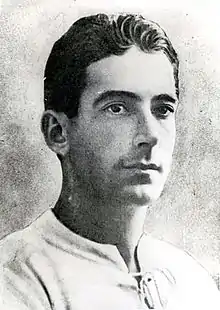
| Rank. | Player | Position | Tenure | Goals |
|---|---|---|---|---|
| 1 | FW | 1912–23 | 244 | |
| 2 | FW | 1911–22 | 207 | |
| 3 | FW | 1916–23 | 141 | |
| 4 | FW | 1932–38 | 138 | |
| 5 | FW | 1952–54, 1956–62 | 125 | |
| 6 | FW | 1907–12 | 121 | |
| 7 | FW | 1917–33 | 112 | |
| 8 | FW | 1916–31 | 109 | |
| 9 | FW | 1948–55 | 106 | |
| 10 | FW | 1908–27 | 99 |
Coaches since 2000
|
|
Honours
League
National Cups
- Copa Dr. Carlos Ibarguren (5): 1913, 1914, 1916, 1917, 1918 [4][39]
- Copa de Honor Municipalidad de Buenos Aires (4): 1912, 1913, 1915, 1917 [4][39]
- Copa Beccar Varela (1): 1932 [4][39]
- Copa de Competencia (LAF) (1): 1933 [4][39]
- Copa de Competencia Británica (1): 1945 [4][39]
- Trofeo de Campeones de la Superliga Argentina (1): 2019 [4]
Other cups
- Copa Bullrich (1): 1910 [note 1]
International
- Intercontinental Cup (1): 1967 [4]
- Copa Libertadores (1): 1967 [4]
- Supercopa Sudamericana (1): 1988 [4]
- Supercopa Interamericana (1): 1988 [41] [note 2]
- Copa de Honor Cousenier (1): 1913 [4]
- Copa Aldao (2): 1917, 1918 [4]
Friendly
- Trofeo Costa del Sol (1): 1968
Notes
- The Copa Bullrich was an official football competition contested by clubs playing in the Second Division. The AFA has not included this competition into the list of national cups because only teams in Primera División participated in those competitions.[40]
- As champion of Supercopa, Racing played the Concacaf champion of "Copa Camel", winning 30. Nevertheless, when Conmebol published a list of its official competitions in 2015, the Supercopa Interamericana was not included.[3] Since then, Racing has claimed the competition be declared official.[5]
References
- Campeones del fútbol argentino on AFA website
- Los apodos de los clubes on Fútbol de Argentina Archived 21 June 2008 at the Wayback Machine, 21 September 2008
- Las competiciones oficiales de la CONMEBOL on Conmebol website, 19 Ago 2015
- "Palmares" (in Spanish). Racing Club. Retrieved 14 November 2017.
- A 32 años de la Supercopa Interamericana de Racing, un logro negado por Conmebol on TyC Sports, 17 Sep 2020
- "Polideportivo J. Camba – Racing Club – Sitio Oficial".
- Así nació la Academia on Olé
- "RACING CLUB DE AVELLANEDA". Soccerway. Perform. Retrieved 18 May 2020.
- El ascenso fue un paso necesario by Alejandro Fabbri on Perfil.com, 8 Mar 2015
- "Argentina 1911". RSSSF. La Nación and La Prensa (Buenos Aires). Retrieved 21 December 2016.
- Argentina 1913 by Osvaldo Gorgazzi at the RSSSF
- Copa Ibarguren overview by Osvaldo Gorgazzi at RSSSF
- "Argentina 1915".
- "Argentina 1919".
- Osvaldo Gorgazzi and Hector Martinez (8 December 2016). "Argentina - List of Champions and Runners-up". RSSSF. Retrieved 17 May 2020.
- Argentina: List of Topscorers by Ricardo Gorosito and Osvaldo Gorgazzi on RSSSF
- Argentina - Torneo Competencia Británica on RSSSF
- "Futbol - Universofutbol.com - Futbol argentino e internacional – La Página de estadística y futbol".
- Argentina 1966 on RSSSF.com
- Racing 67 on El Gráfico
- "Argentina 1976".
- "Argentina Second Level 1984". www.rsssf.com. Retrieved 13 October 2020.
- "Argentina Second Level 1985".
- "Racing win marathon for Argentina's first crown: A brief history..." FIFA. 23 April 2007. Retrieved 23 May 2020.
- Historia de Racing at official website
- "Diego Cocca es el nuevo entrenador de Racing", La Voz, 15 Jun 2014
- "Milito arregló con Racing, firmó y en su presentación reconoció: "Desde que me fui, supe que iba a volver", Infobae, 17 Jun 2014
- "Racing es campeón del fútbol argentino después de 13 años" on CanchaLlena.com, 14 Dec 2014
- "Racing campeón: brilla blanca y celeste" on Olé, 14 Dec 2014
- "Tras 13 años, Racing se desahogó con un campeonato histórico", Perfil.com, 14 Dec 2014
- ""Licha" López, el goleador más veterano de la historia del profesionalismo". FOX Sports (in Spanish). Retrieved 2 April 2020.
- "Nuevo récord para Licha López: El goleador más veterano del fútbol argentino". MARCA Claro Argentina (in Spanish). 8 April 2019. Retrieved 2 April 2020.
- Clarín.com. "Lisandro López, el goleador y rompe records del Racing que está a punto de gritar campeón". www.clarin.com (in Spanish). Retrieved 2 April 2020.
- "Estadio Presidente Perón". Soccerway. Global Sports Media. Retrieved 18 June 2012.
- Características del estadio at Club's official website.
- "Racing Club squad". Soccerway. Retrieved 20 March 2020.
- Segunda División – Campeones on AFA website
- "CIHF: Historia - Campeones del Fútbol Argentino".
- "Argentina - Domestic Cup History". RSSSF. 14 November 2017. Retrieved 14 November 2017.
- Campeones de Primera División on AFA website
- Palmarés: Supercopa Interamericana